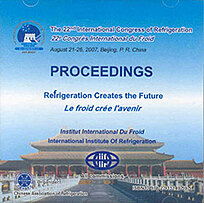
Document IIF
Station d'essais ATP, transport frigorifique international : l'accord ATP, et conséquences pour l'environnement.
ATP test station, international refrigerated transport: ATP Agreement, consequences on the environment.
Auteurs : CHATZIDAKIS K., CHATZIDAKIS S.
Résumé
Some of the alternatively proposed ATP testing procedures for checking the in-service and second hand refrigerated transport equipment have failed in their conception and it is possible according to the choice of testing methods to come to incorrect results, concerning the actual effectiveness of the thermal insulation and the efficiency of the cooling appliances of the tested specimen. The consequences are, apart from the attestation of inefficient equipment with a quality deficit, endangering public health, an increase in the fuel consumption needed for the mechanically driven compressor of the cooling unit of the refrigerated transport equipment and also an increase of the CO2 emissions and the environmental pollution. This study analyses ATP testing procedures, investigates the impact on the environment and gives some proposals for improvement. Also a simulation model is introduced using a transient finite difference algorithm, developed for a modern ATP Test chamber and a typical specimen vehicle to be tested. Simulation results are compared to experimental measurements taken under real conditions by a data acquisition system.
Documents disponibles
Format PDF
Pages : ICR07-D2-653
Disponible
Prix public
20 €
Prix membre*
Gratuit
* meilleur tarif applicable selon le type d'adhésion (voir le détail des avantages des adhésions individuelles et collectives)
Détails
- Titre original : ATP test station, international refrigerated transport: ATP Agreement, consequences on the environment.
- Identifiant de la fiche : 2007-2812
- Langues : Anglais
- Sujet : Réglementation
- Source : ICR 2007. Refrigeration Creates the Future. Proceedings of the 22nd IIR International Congress of Refrigeration.
- Date d'édition : 21/08/2007
Liens
Voir d'autres communications du même compte rendu (839)
Voir le compte rendu de la conférence
-
Prove di rinnovo sui furgoni isotermici.
- Auteurs : GATTA A.
- Date : 29/06/2001
- Langues : Italien
- Source : Le ultime tecnologie del freddo e del condizionamento./ Latest technologies in refrigeration and air conditioning.
Voir la fiche
-
Importance of the ATP Agreement for transport o...
- Auteurs : Transfrigoroute int., EILSOE M.
- Date : 21/09/2001
- Langues : Anglais
- Source : Transfrigoroute International. 22 Kongress, Sofia, 2001./ Transfrigoroute International. 22nd Congress, Sofia, 2001./ Transfrigoroute International. 22e Congrès, Sofia, 2001.
Voir la fiche
-
ATP regulation: how a food safety standard can ...
- Auteurs : CAVALIER G.
- Date : 12/06/2009
- Langues : Anglais
- Source : Latest technologies in refrigeration and air conditioning: energy issues and climate change, new refrigerants, new European regulations, new plants, the cold chain. XIII European Conference: June 12-13, 2009, Milan.
- Formats : PDF
Voir la fiche
-
Temperature-controlled transport: technical and...
- Auteurs : Transfrigoroute int., BILLIARD F.
- Date : 03/10/2002
- Langues : Français
- Source : Transfrigoroute International. Jahresversammlung, Oliva, 2002./ Transfrigoroute International. Annual meeting, Oliva, 2002./ Transfrigoroute International. Assemblée annuelle, Oliva, 2002.
Voir la fiche
-
Une vision genevoise de l'ATP et du transport c...
- Auteurs : CLIPPEL M. de
- Date : 03/08/1992
- Langues : Français
Voir la fiche
